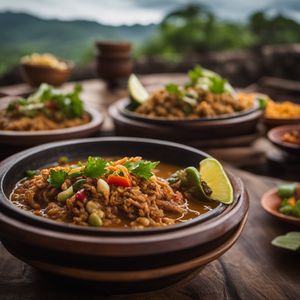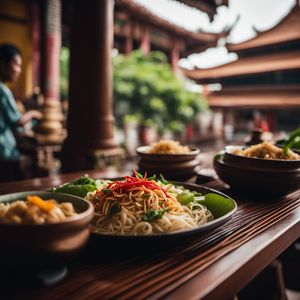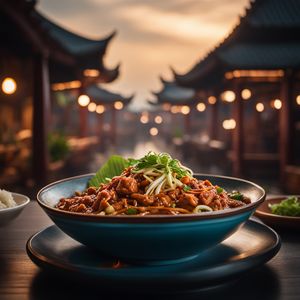
Dish
Chè lam
Che lam
Chè lam is made by boiling glutinous rice balls in coconut milk and sugar. The rice balls are made by mixing glutinous rice flour with water and shaping them into small balls. The coconut milk is then mixed with sugar and boiled until it thickens. The rice balls are added to the coconut milk mixture and cooked until they are soft and chewy. Chè lam is usually served cold and garnished with sesame seeds or chopped peanuts.
Origins and history
Chè lam is a traditional Vietnamese dessert that has been enjoyed for generations. It is believed to have originated in the Mekong Delta region of Vietnam.
Dietary considerations
Glutinous rice balls are high in carbohydrates and may not be suitable for individuals with diabetes or those on a low-carb diet. Coconut milk is high in saturated fat and may not be suitable for individuals with high cholesterol or those on a low-fat diet.
Variations
There are many variations of chè lam, including chè trôi nước, which is made with mung bean paste instead of glutinous rice balls. Some recipes also call for the addition of pandan leaves or ginger for added flavor.
Presentation and garnishing
Chè lam is traditionally served in a small bowl or cup. It can be garnished with sesame seeds, chopped peanuts, or fresh fruit. A sprig of mint or basil can also be added for a pop of color and flavor.
Tips & Tricks
To make the rice balls, be sure to use glutinous rice flour, which is different from regular rice flour. The rice balls should be small and uniform in size to ensure even cooking. Be sure to stir the coconut milk mixture constantly to prevent it from burning or sticking to the bottom of the pot.
Side-dishes
Chè lam can be served with a variety of side dishes, including fresh fruit, such as mango or lychee, or sweet sticky rice. It can also be served with a scoop of ice cream for a decadent dessert.
Drink pairings
Chè lam pairs well with a variety of drinks, including Vietnamese iced coffee or green tea. It can also be served with a sweet dessert wine, such as a late harvest Riesling.
Delicious Chè lam recipes
More dishes from this category... Browse all »

Aamras
Indian cuisine

Aasmi
Indian cuisine

Agra petha
Indian cuisine

Aiyùbīng
Taiwanese cuisine

Ajdnek
Slovenian cuisine

Akafuku
Japanese cuisine

Akanés
Greek cuisine

Akumaki
Japanese cuisine
More cuisines from this region... Browse all »

Bruneian cuisine
Bold, Complex, Spicy, Savory, Sweet

Burmese cuisine
Salty, Sour, Spicy, Umami, Sweet

Cambodian cuisine
Salty, Sour, Spicy, Umami, Sweet

Christmas Island cuisine
Salty, Sour, Spicy, Umami, Sweet

East Timor cuisine
Spicy, Savory, Sweet, Sour, Umami

Filipino cuisine
Sweet, Sour, Savory, Spicy, Umami

Lao cuisine
Savory, Spicy, Sour, Umami

Malaysian cuisine
Spicy, Sweet, Sour, Savory
